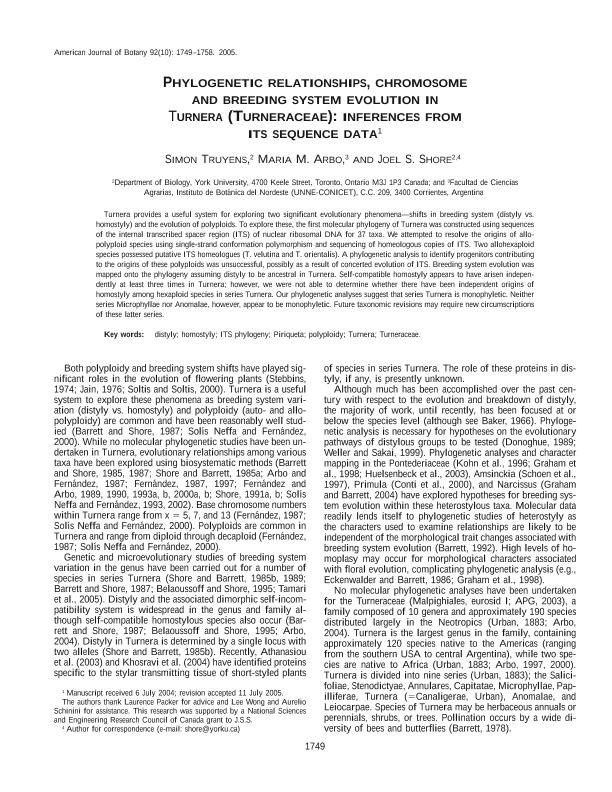Mostrar el registro sencillo del ítem
dc.contributor.author
Truyens, Simons
dc.contributor.author
Arbo, Maria Mercedes

dc.contributor.author
Shore, Joel S.
dc.date.available
2017-12-13T16:59:27Z
dc.date.issued
2005-12
dc.identifier.citation
Truyens, Simons; Arbo, Maria Mercedes; Shore, Joel S.; Phylogenetic relationships, chromosome and breeding system evolution in Turnera (Turneraceae): inferences from ITS sequence data; Botanical Society of America; American Journal of Botany; 92; 10; 12-2005; 1749-1758
dc.identifier.issn
0002-9122
dc.identifier.uri
http://hdl.handle.net/11336/30450
dc.description.abstract
urnera provides a useful system for exploring two significant evolutionary phenomena—shifts in breeding system (distyly vs. homostyly) and the evolution of polyploids. To explore these, the first molecular phylogeny of Turnera was constructed using sequences of the internal transcribed spacer region (ITS) of nuclear ribosomal DNA for 37 taxa. We attempted to resolve the origins of allopolyploid species using single-strand conformation polymorphism and sequencing of homeologous copies of ITS. Two allohexaploid species possessed putative ITS homeologues (T. velutina and T. orientalis). A phylogenetic analysis to identify progenitors contributing to the origins of these polyploids was unsuccessful, possibly as a result of concerted evolution of ITS. Breeding system evolution was mapped onto the phylogeny assuming distyly to be ancestral in Turnera. Self-compatible homostyly appears to have arisen independently at least three times in Turnera; however, we were not able to determine whether there have been independent origins of homostyly among hexaploid species in series Turnera. Our phylogenetic analyses suggest that series Turnera is monophyletic. Neither series Microphyllae nor Anomalae, however, appear to be monophyletic. Future taxonomic revisions may require new circumscriptions of these latter series.
dc.format
application/pdf
dc.language.iso
eng
dc.publisher
Botanical Society of America

dc.rights
info:eu-repo/semantics/openAccess
dc.rights.uri
https://creativecommons.org/licenses/by-nc-sa/2.5/ar/
dc.subject
Distyly
dc.subject
Homostyly
dc.subject
Its Phylogeny
dc.subject
Piriqueta
dc.subject
Polyploidy
dc.subject
Turnera
dc.subject
Turneraceae
dc.subject.classification
Otras Ciencias Biológicas

dc.subject.classification
Ciencias Biológicas

dc.subject.classification
CIENCIAS NATURALES Y EXACTAS

dc.title
Phylogenetic relationships, chromosome and breeding system evolution in Turnera (Turneraceae): inferences from ITS sequence data
dc.type
info:eu-repo/semantics/article
dc.type
info:ar-repo/semantics/artículo
dc.type
info:eu-repo/semantics/publishedVersion
dc.date.updated
2017-12-04T17:27:52Z
dc.identifier.eissn
1537-2197
dc.journal.volume
92
dc.journal.number
10
dc.journal.pagination
1749-1758
dc.journal.pais
Estados Unidos

dc.journal.ciudad
St. Louis, MO
dc.description.fil
Fil: Truyens, Simons. York University, Ontario; Canadá
dc.description.fil
Fil: Arbo, Maria Mercedes. Consejo Nacional de Investigaciones Científicas y Técnicas. Centro Científico Tecnológico Conicet - Nordeste. Instituto de Botánica del Nordeste. Universidad Nacional del Nordeste. Facultad de Ciencias Agrarias. Instituto de Botánica del Nordeste; Argentina
dc.description.fil
Fil: Shore, Joel S.. York University, Ontario; Canadá
dc.journal.title
American Journal of Botany

dc.relation.alternativeid
info:eu-repo/semantics/altIdentifier/url/http://www.amjbot.org/content/92/10/1749.abstract
dc.relation.alternativeid
info:eu-repo/semantics/altIdentifier/doi/http://dx.doi.org/10.3732/ajb.92.10.1749
Archivos asociados
